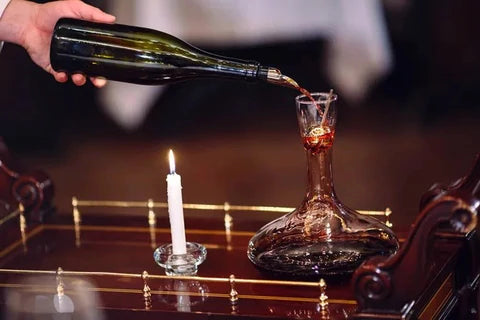The definition that we find in the dictionary corresponding to the term decantation, derivation of decanting, provides the explanation of a process through which a separation of mixtures of immiscible liquids, or of a liquid mixture, and solid like a suspension takes place. THEn oenology, this operation has the purpose of progressively freeing the wine from organic substances and in general from solid particles in suspension both through periodic decanting and with other interventions.

The decanting some wine it is an operation which is used in conjunction with particularly aged wines; once uncorked, for faster oxygenation than in the bottle due to the narrow neck of the latter, the wine is slowly poured into a crystal or transparent glass carafe. Inside this container, also known as Decanter, characterized by a shape that recalls an ampoule, the flat bottom and the longer neck wider at the top, it is essential to separate any solid parts or sediments present on the bottom of the wine bottles. and speed up the clarification process.

If you decide to taste a particularly aged wine, it is recommended to put the bottle in a vertical position for at least 24 hours before opening it, to ensure that the sediments settle on the bottom. Once opened, proceed by pouring the wine very slowly into the Decanter, and holding a light under the neck of the bottle (sommeliers use a candle) it is necessary to check and stop as soon as you see the sediments or the color of the wine becomes slightly cloudy. These deposits can attenuate the expression and flavor of wines, but are still an indication of good quality.

Let's talk now about oxygenation; in many cases it occurs simply by uncorking the bottle, leaving the wine the necessary time to release all its flavors and aromas. The evolution of a red wine begins in the barrel, continues in the bottle through oxygenation, and continues in the glass where it develops its aroma at its best. It is a very important process that requires different times depending on the type of wine; for a mature one it would be appropriate to do it for about an hour, while a young one does not need it.
Let's now focus our attention on the serving temperature of the wines by identifying which is the correct one. Each type of wine requires its ideal temperature; it is on the basis of this that the organoleptic characteristics improve or worsen.

With a perfect service, great bottles can be enhanced, but also some gaps can be remedied by making a mediocre wine better. Low temperatures enhance the hardness, tannins, acidity and flavor; while, on the contrary, the highs accentuate the softness, sugars, alcohols and sugar alcohols. This is why sparkling wines and white wines, especially young and rather acidulous, are enhanced when served cold, because it is thanks to the low temperature that the varietal aromas, bitter notes and freshness are emphasized. A temperature below 13 degrees accentuates the more pungent and dry notes of white wines, balances the sweet tones, and makes them more pleasant to taste and smell. For the rosé ones it is necessary to consider the possible presence of tannins and, taking this into account, if they are young and fresh they should be served between 10-12 degrees, while if more mature and full-bodied between 12-14 degrees.
As for the reds, surely we have all heard of the "rule" according to which this type of wine is served and tasted at room temperature; in reality, there is nothing more wrong, because we should consider the thermal situation of the environment in which the bottle is located and, if necessary, correct the degrees. Younger red wines, with a vinous floral scent, should be served between 14-16 degrees, while those of medium structure with not too impetuous tannins will be served between 16-18 degrees. The "important" ones with great structure and tannins, and which follow a long refinement, are served at a temperature of 18-20 degrees.
For passito and fortified wines the temperature changes with the variation of sweetness, starting from 10 degrees for young and dry fortified wines, while for more mature and complex less sweet ones, it is 10-14 degrees.
Pay attention and do not underestimate the importance of the serving temperature of the wine, as it is essential to taste and appreciate the organoleptic qualities of a good vintage glass or any other type of wine. Below we leave you with a summary graphic info table on the recommended temperatures.
"Wine is a wonderfully appropriate thing for man if, in health as in sickness, it is drunk purposefully and with measure, according to the individual constitution".
(Hippocrates)












 Include a free greeting card by writing your message in the dedicated field at Checkout
Include a free greeting card by writing your message in the dedicated field at Checkout





